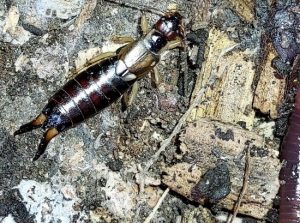Over-Wintering Insects Where Are they and What to Do about Them?
In July, hornworms appeared in vast numbers devouring my tomato plants! When my Swiss Chard or beans come up in spring, earwigs chew the new shoots, as do slugs and pill bugs.
Where do they come from, appearing from nowhere? All winter long, cold and dark, I seldom see any of these critters, but once it starts to warm up, look out!
Winter can be a hard time for invertebrates (insects and spiders). Cold weather slows them down, making them easier prey, and the cold can kill. They’ve come up with multiple ways to survive, from burrowing and hibernating to finding warm places into which to escape. Favorite overwintering spots are leaf piles, bark or mulch; then, they emerge in spring to do what they do best, helpful or not.
Cleaning up will help keep many of these insects from finding an easy way into your much warmer home during the winter season. Preventive measures will help reduce populations of undesirables come spring. It’s not such a simple problem, though.
Take earwigs, for instance, (and no, they don’t crawl in your ears). Earwigs are beneficial, as well as pests. They eat aphids, molds and fungi, and help make compost. Unlike most insects, female earwigs take care of their eggs until they hatch, even eating mold off the eggs (ugh). But they also like to nibble tender spring shoots. Earwigs congregate together in large numbers and, frankly, they’re creepy looking! That being said, they like to overwinter under leaf piles, bark and mulch.
Tomato hornworms hibernate as large, reddish-brown pupae underground, emerging in spring as Sphinx moths. Tilling the garden in late fall, as well as early spring, helps control populations. However, tilling disturbs helpful soil microorganisms. I avoid tilling for that reason; thus, a few more hornworms. Mulching around tomato plants in spring is helpful to prevent moths from emerging. Crop rotation is another good preventive measure.
Cabbage white moths generate little green worms that devour anything in the cabbage family. These overwinter as chrysalises on plant stalks—a good reason for clearing up expired vegetation.
Other overwintering invertebrates of interest are praying mantises and ladybugs, both beneficial insects. Praying mantises lay their eggs in a sac (up to 400 eggs) usually attached to a plant stalk. The sac hardens into a tough brown shell that hatches in spring. Ladybugs congregate together, huddling with hundreds or thousands of other beetles, to protect themselves from weather and freezing. They find places in cracks, crevices, tree bark, and even your house or roof to spend the winter. In the spring they emerge flying in masses, an awesome sight.
Preventive measures include cleaning up mulch, leaves and bark, especially around your home’s foundation. Winterize by sealing door jambs and window frames; place screening over vent access points; install door sweeps and thresholds. Perhaps till gardens for the ones that dig in! But, let’s recognize the diversity and complexity of these creatures that both invade and protect. Practice a little “live and let live.” (Well, maybe not for cockroaches!)
Nancy Bliss is a University of California Cooperative Extension Master Gardener of Tuolumne County.

